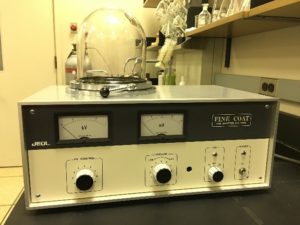SCANNING ELECTRON MICROSCOPE (SEM) – JEOL 6360LV
 JSM-6360LV low vacuum SEM is a high-performance scanning microscope for fast characterization and imaging of fine structures. The selectable Low Vacuum mode allows for observation of specimens that cannot be viewed at high vacuum due to excessive water content or because they have a non-conductive surface.
JSM-6360LV low vacuum SEM is a high-performance scanning microscope for fast characterization and imaging of fine structures. The selectable Low Vacuum mode allows for observation of specimens that cannot be viewed at high vacuum due to excessive water content or because they have a non-conductive surface.
With a high resolution of 3.0nm at 30kV, the JSM-6360LV delivers amazing clarity of the finest structures.
EDX DETECTOR – OXFORD X-MAX
 EDX is an analytical technique used for the elemental analysis or chemical characterization of a sample. It relies on an interaction of some source of X-ray excitation and a sample. Its characterization capabilities are due in large part to the fundamental principle that each element has a unique atomic structure allowing unique set of peaks on its X-ray emission spectrum.
EDX is an analytical technique used for the elemental analysis or chemical characterization of a sample. It relies on an interaction of some source of X-ray excitation and a sample. Its characterization capabilities are due in large part to the fundamental principle that each element has a unique atomic structure allowing unique set of peaks on its X-ray emission spectrum.
CRITICAL POINT DRYER – SAMDRI PVT 3B
 Established method of dehydrating biological tissue prior to examination in the SEM. When this ‘critical point’ is reached, it is possible to pass from liquid to gas without any abrupt change in state. If a specimen had been in the liquid during this process it would have experienced a transition from a ‘wet’ to a ‘dry’ gas environment without being in contact with a surface, in this way avoiding the damaging effects of surface tension.
Established method of dehydrating biological tissue prior to examination in the SEM. When this ‘critical point’ is reached, it is possible to pass from liquid to gas without any abrupt change in state. If a specimen had been in the liquid during this process it would have experienced a transition from a ‘wet’ to a ‘dry’ gas environment without being in contact with a surface, in this way avoiding the damaging effects of surface tension.
SPUTTER COATER (GOLD) – JEOL JFC 1100
 Coating of samples is required in the field of electron microscopy to enable or improve the imaging of samples. Creating a conductive layer of gold on the sample inhibits charging, reduces thermal damage and improves the secondary electron signal required for topographic examination in the SEM. Sputtered films for SEM typically has a thickness range of 2–20 nm.
Coating of samples is required in the field of electron microscopy to enable or improve the imaging of samples. Creating a conductive layer of gold on the sample inhibits charging, reduces thermal damage and improves the secondary electron signal required for topographic examination in the SEM. Sputtered films for SEM typically has a thickness range of 2–20 nm.
SPUTTER COATER (PLATINUM) – JEOL JFC 1600
 Sputter coating for SEM is the process of applying an ultra-thin coating of electrically-conducting metal – such as gold (Au), gold/palladium (Au/Pd), platinum (Pt), silver (Ag), chromium (Cr) or iridium (Ir) onto a non-conducting or poorly conducting specimen. Sputter coating prevents charging of the specimen, which would otherwise occur because of the accumulation of static electric fields. It also increases the amount of secondary electrons that can be detected from the surface of the specimen in the SEM and therefore increases the signal to noise ratio.
Sputter coating for SEM is the process of applying an ultra-thin coating of electrically-conducting metal – such as gold (Au), gold/palladium (Au/Pd), platinum (Pt), silver (Ag), chromium (Cr) or iridium (Ir) onto a non-conducting or poorly conducting specimen. Sputter coating prevents charging of the specimen, which would otherwise occur because of the accumulation of static electric fields. It also increases the amount of secondary electrons that can be detected from the surface of the specimen in the SEM and therefore increases the signal to noise ratio.
Rotational and Oscillation Rheometry
 Rheometer – A rheometer is used to measure the way in which a liquid, suspension or slurry flows in response to applied forces.
Rheometer – A rheometer is used to measure the way in which a liquid, suspension or slurry flows in response to applied forces.
Rotational and Oscillation rheometry are the two-powerful technique for the measurement of complex shear rheology across all material types – sensitive enough to measure the viscosity of dilute polymer solutions, and yet robust enough to measure the viscoelasticity of high modulus polymers or composites.
FTIR SPECTROSCOPY – THERMO NICOLET IS10
 FTIR spectra reveal the composition of solids, liquids, and gases. The most common use is in the identification of unknown materials and confirmation of production materials. The information content is very specific in most cases, permitting fine discrimination between like materials. Widely used in microanalysis of small sections of materials to identify contaminants, Analysis of thin films and coatings, Monitoring of automotive or smokestack emissions, Failure analysis etc.
FTIR spectra reveal the composition of solids, liquids, and gases. The most common use is in the identification of unknown materials and confirmation of production materials. The information content is very specific in most cases, permitting fine discrimination between like materials. Widely used in microanalysis of small sections of materials to identify contaminants, Analysis of thin films and coatings, Monitoring of automotive or smokestack emissions, Failure analysis etc.


